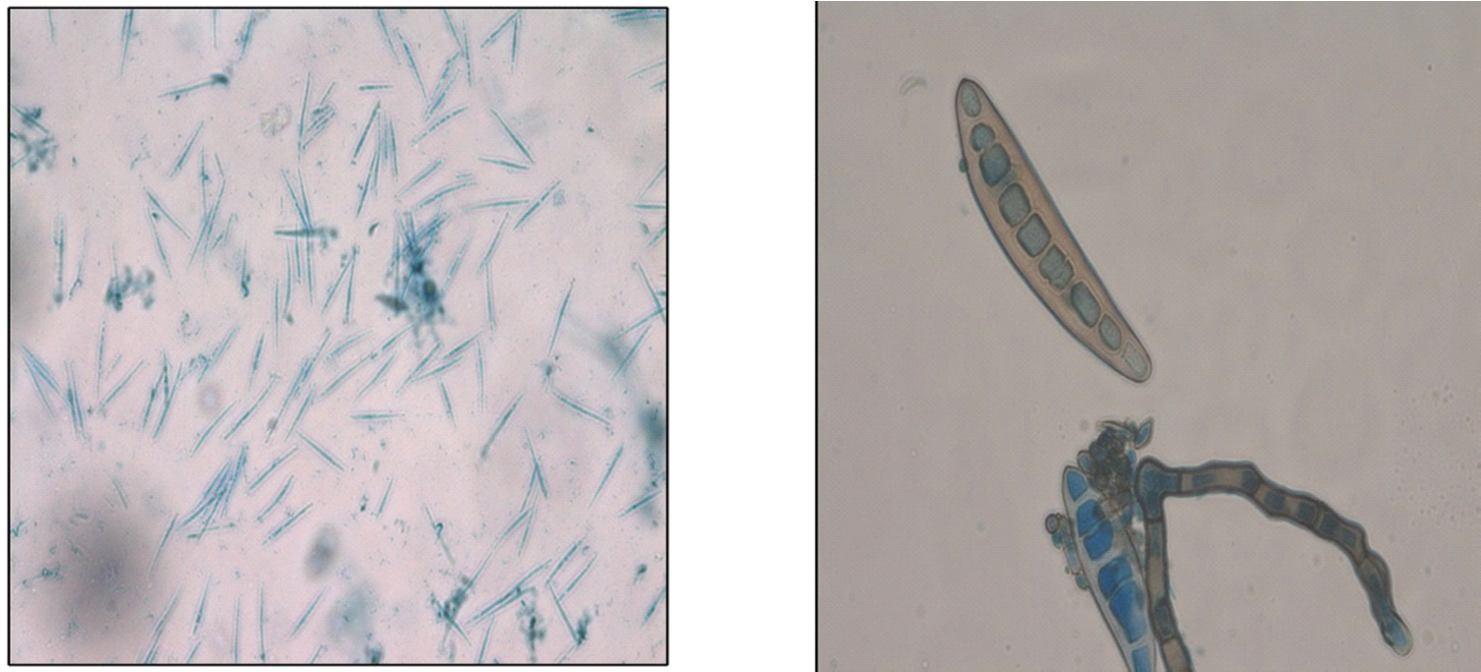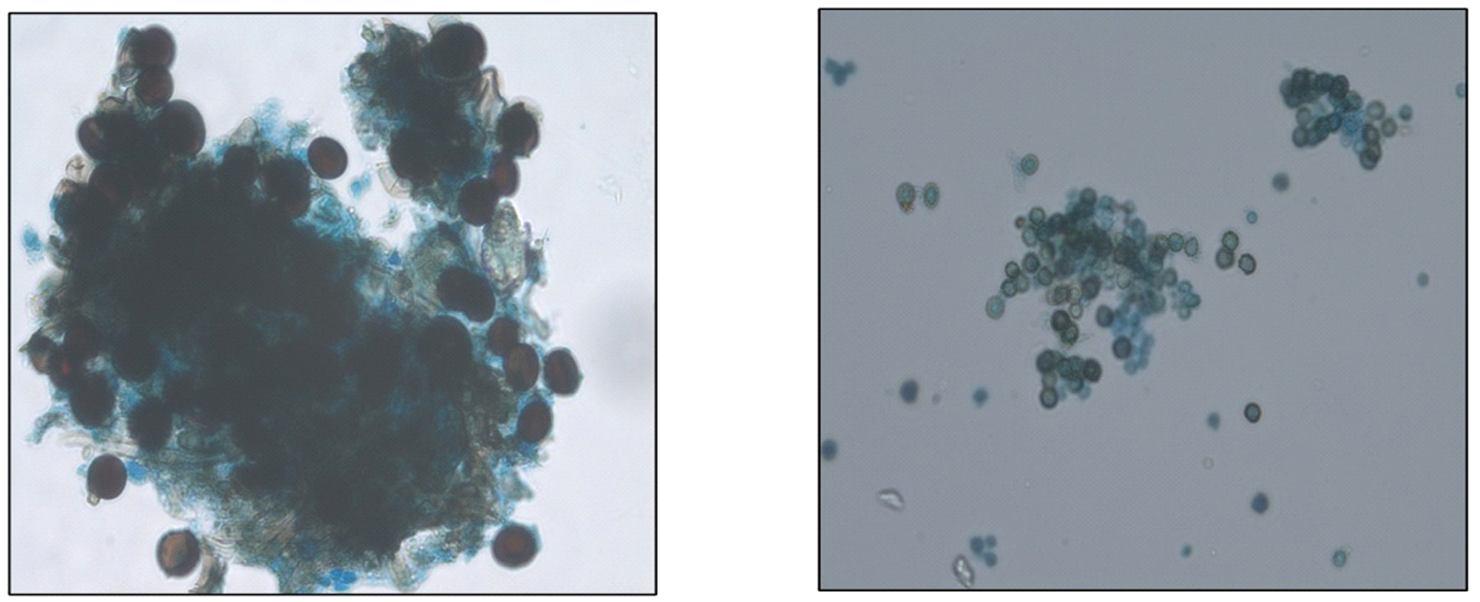

Fungi and Other Associates from Rice Fields of Bhor and Velhe Talukas of Pune District, Maharashtra State, India
Mrs. Savita Anand Gaikwad Department of Botany, Anantrao Thopte College, Bhor (Pune), IndiaAbstract: Plant pathogens are major cause of diseases in crops and plants. These plant pathogens devastated our crops and led us to devise methods and to search cultivars for resistant. Rice crops suffer from infection of many bacterial, viral and fungal diseases. The aim and objective of present study is to find out information about different plant pathogens caused by fungal infection. The survey of rice fields was carried out in Bhor and Velhe Talukas of Pune district. In case of rice crop, several diseases are reported such as Bacterial Blight, rice blast, Aggregate sheath spot, Black kernel Brown spot, Downy mildew, false smut, etc.
Keywords: Bhor, Velhe, Pathogen, Paddy, Scouting.
I. INTRODUCTION
Rice is a staple food for majority of population in the world. The production of rice is increased quantitatively and qualitatively and it is generating additional income sources. Rice is the seed of the grass species oryza sativa. Bhor and Velhe talukas are known for large production of rice. The farmers chiefly cultivate rice as major food crop. The detail survey was conducted in Bhor and Velhe talukas to study plant pathogens attacking the rice crops. Recently so many studies have been conducted on pathogen of rice. References [9] and [12] have undertaken study of ustilagonoidea virens. Reference [8], find out method of management of stem rot disease of paddy by using fungicides. The causative agent was sclerotium oryzae. Reference [7], exhibited economic and environmental impact of rice blast pathogen.
II. MATERIALS AND METHODS
To study different types of rice disease in the field of different villages of Bhor and Velhe talukas. The scouting was carried out at the vegetative and seedling growth stage. The symptoms and causes of the disease are noted in the field book. The Photographs have been taken in order to record occurrences. Disease identification was done based on information on related symptoms with the help of Expert, journals, Books, Monograph and research paper.
During the survey of rice fields from Bhor and Velhe, the infected paddy samples were collected during dry season shortly before harvest period. Collected samples were labelled, packed in polythene and taken to the laboratory for further identification. The samples were identified at Agharkar Research Institute in the department of mycology and plant pathology group.
A. Description of Study Area

The survey was conducted during 2011 2012 in cropping season of major rice growing fields of different villages of Bhor and Velhe talukas of Pune district. The average annual rain fall of Bhor is 643.5 to 800mm and Velhe is 2314 to 2645mm.The weather is very extreme in all season with temperature in summer at high 40 degree Celsius and in winter as cool as 8 degree Celsius Bhor and Velhe talukas has mix economy with agriculture, and forest resources, contributing to it.
III. RESULT AND DISCUSSION
A. Following Diseases Were Noted
1) Downy Mildew of Rice
Pathogen Sclerophthora macrospora

Symptoms
Formation of small, pale yellow or light green spots on the upper leaf surface. Discoloration of leaf surface.
International Journal for Research in Applied Science & Engineering Technology (IJRASET)

ISSN: 2321 9653; IC Value: 45.98; SJ Impact Factor: 7.538 Volume 10 Issue IX Sep 2022 Available at www.ijraset.com
The white fluffy pathogen develops on lower surface of infected leaf. Control measures
Cholorothalonil and Mancozeb are the powerful fungicides for Downy mildew
2) Eye Spot of Rice
Pathogen Drechslera gigantean Symptoms
Formation of eye shaped lesions on leaf sheath in young stage of plant
Small size water soaked spots appear on the leaves and finally, olivaceous dots or rings. Control measures
Plant clean seeds.
Remove collateral weed host from bunds and channels. Treat seed with fungicides. Crop rotation is also important to control disease.
3) Panicle branch rot of Rice
Pathogen Nigrospora oryzae Symptoms
Branches of panicle rot due to fungal infection Nigrospora. Control measures
Use of resistance varieties.
Treat seeds with suitable fungicides.
4) Blossom Blight of rice
Pathogen Cladosporium tenuissimum Symptoms
Start Fungus infects the stigma of a flower which led to the blossom blight of rice. Control measures
The spray of Mancozeb and Carbendazim produced highest protection. Removal of infected plant part from the field.
5) Alternaria Leaf spot of Rice Pathogen Alternaria longissima Symptoms
Leaf symptoms shows formation of brown round spot with concentric rings. Spot occurs first on older leaf and then spread throughout whole plant. Control Measures
Use of fungicides like pyraclostrobin and azoxystrobin plus difenoconazole. Fluxapyroxad plus pyraclostrobin also effective for alternaria.
6) Stem Rot of Rice
Pathogen Sclerotium oryzae

Symptoms
Formations of numerous tiny white and black sclerotia.
Small irregular black lesions on the outer sheath near water level. Lesions expand as the disease advance. Light ear and to throw out green shoot from the base. Infected culm lodges and caused unfilled panicles and chalky grain. Control measures
Use of disease resistance variety. Drain the field to reduce sclerotia.
Burning of straw after harvesting crops. Proper use of fertilizers and chemicals.
ISSN: 2321 9653; IC Value: 45.98; SJ Impact Factor: 7.538

Volume 10 Issue IX Sep
at www.ijraset.com
Infection
Use
(0.1%)
IR22,
50%
List

Table
Bhor
Velhe Taluka
Remark
I Nazare Nigrospora sphaerica (Sacc.) Mason
II Bare Cladosporium oxysporum Berk. & Curt.


III Hatnoshi Cladosporium tenuissimum Cooke

IV Kari Ephelis
V Sakhar Sporisorium sp.
VI Adwali Alternaria longissima Deighton & Mc Garvie
VII Vinzar Volutella sp.
VIII Dapode Drechslera sp.
Of
Vertebrates And Invertebrates In Rice Field

case of rice fields
insects feed at different stages of growth. Grasshoppers belong to the super family Acridoidea and Pyrgomorphoidea of the order Orthoptera and suborder Caelifera. Acridoidea shows maximum diversity and constitutes only one family i.e., Acrididae whereas pyrgomorphoidea also has only one family i.e., Pyrgomorphidae, widely distributed in India. Grasshoppers are of great economic importance, because they constitute an important group of pests and pose a constant threat to cereal crops, pulses, vegetables, orchards, grassland and forest plantations all over the world. Grasshoppers cause significant damage to tree seedlings and agricultural crops (Joshi et al., 1999), hence considered as oligophagous and according to host preferences classified as graminivorous, forbivorous and ambivorous or mixed feeders (Mulkern 1967). Grasshopper can damage rice
stage of


defoliations. However, in present study some invertebrate pests

by cutting the edges of leaves. When found in greater number can feed
growth.
IV. CONCLUSION

During Rice field survey more than nine diseases like stem rot, false smut, downy mildew, eye spot, panicle branch rot, blossom blight, alternaria leaf spot etc. were found in different places of both talukas. Diseases are favored by long dew period increased by fog, shade and frequent light rain and become worse when temperature slightly cooler. This decreases the yield of rice. Rice fields are a preferred habitat of amphibians and these insectivorous vertebrates function as important natural enemies of pest insects. On this background amphibians, fishes, insects etc. were recorded.
REFERENCES
[1] Alagarsamy, G. And Bhaskaran, R., 1987. Sheath rot of rice. In Kannaiyan, S. (ed). Advances in rice pathology, TNAU, Coimbatore

[2] BP Tripathi, NK Mishra, BS Parihar and Richa Mishra. Assessment of IDM modules with some fungicides for rice blast in Chhattisgarh. The Pharma Innovation Journal 2022; SP 11(4): 21 24
[3] DT Khedkar, PG Borkar, RA Karande, VM Karade and RA Raut. Variability studies of rice blast fungus in Konkan region of Maharashtra. International Journal of Chemical Studies 2020; 8(1): 1402 1404
[4] Joshi P. C, J.A. lockwood, N. Vashishth and A. Singh 1999.Grasshopper (Orthoptera: Acridoidea) Community dynamics in a moist Deciduous Forest in India. Journal of Orthoptera Research 8:17 23

[5] Mulkern,G.B.(1967) Food Selection by Grasshoppers. Annual Review of Entomology,12,59 78.
[6] Murthy HB1, Ganesha Naik R1, Mukesh Sehgal2, Meenakshi Malik2 Integrated Management of Rice Diseases Special Issue on Status of Information and Communication Technology in the Successful Implementation of IPM Volume 4, Issue 2 2021, Pg. No. 13 24.
[7] Nalley L., Tsiboe F., Durand Morat A., Shew A. and Thoma G. (2016) PLoS One, 11(12), e0167295
[8] Pramesh,et.al A combination fungicide for the management of sheath blight, sheath rot and stem rot disease of paddy. International Journal of current microbiology and applied sciences 6(9),3500 3509,2017
[9] Rashmi C.R., Gokulpalam, Girija V.K. and Surendran M. (2016) International Journal of Applied & Pure Science and Agriculture, 02(3),2394 5532.

[10] Sayeda Parveen Qureshi*, Belurkar Yogita, Mehar Pooja, Kodape Dipali and Selokar Monali. Research Article Study Of Diseases On Rice (Oryza Sativa) In Major Growing Field Of Bhandara District International Journal of Agriculture Sciences ISSN: 0975 3710&E ISSN: 0975 9107, Volume 10, Issue 6, 2018, pp. 5573 5575.
[11] Shamim Shamsi*, Najmun Naher1, Pranami Chowdhury2 And sMst. Selina Momtaz3. Fungal Diseases Of Three Aromatic Rice (Oryza Sativa L.). Journal Of Bangladesh Academy of Sciences, Vol. 34, No. 2, 163 170, 2010
[12] Singh A., Abhilasha A., Simon S.L., Singh A., Rao V., Kamuladdeen & Arun A. (2014) Survey of false smut (Ustilaginoidea virens) of rice (Orzya Sativa L.). In selected district of U.P., 9(1), 389 3.
[13] Suchismita Samal, Sagarika Parida.Major Fungal Diseases of Rice: A Case Study. Asian Journal of Biological and Life Sciences, Vol 10, Issue 2, May Aug, 2021
[14] Shubhransu Nayak1*, Soma Samanta2, Chandan Sengupta3, Soumya Sephalika Swain1.Rice crop loss due to major pathogens and the potential of endophytic microbes for their control and management. Journal of Applied Biology & Biotechnology Vol. 9(05), pp. 166 175, September, 2021
[15] Sumit Shekhar*, Diksha Sinha and Anita Kumari. An Overview of Bacterial Leaf Blight Disease of Rice and Different Strategies for its Management Int.J.Curr.Microbiol.App.Sci (2020) 9(4): 2250 2265
[16] Wilawan Chuaboon*, Nattapone Ponghirantanachoke, Dusit Athinuwat. Application of Wood Vinegar for Fungal Disease Controls in Paddy Rice.App. Envi. Res. 38(3) (2016): 77 85

